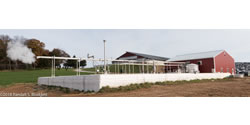DVO Commissions First Anaerobic Digester Installation in Pennsylvania
 Installation and construction are complete on a DVO Inc. anaerobic digester at Ar-Joy Farm, a dairy farm in Cochranville, Pennsylvania. This is DVO’s first installation in Pennsylvania, bringing the number of states with a DVO digester to 19. Its patented digester system has also been constructed in six foreign countries.
Installation and construction are complete on a DVO Inc. anaerobic digester at Ar-Joy Farm, a dairy farm in Cochranville, Pennsylvania. This is DVO’s first installation in Pennsylvania, bringing the number of states with a DVO digester to 19. Its patented digester system has also been constructed in six foreign countries.
Anaerobic digestion (AD) is a collection of processes by which naturally occurring microorganisms transform waste into valuable byproducts in a controlled, oxygen-free environment. DVO’s patented Two-Stage Linear Vortex™ anaerobic digester is unlike any other technology. Traditional AD technologies featuring above-ground tanks are inefficient and costly to operate.
“We are honored to be working with Marilyn and Duane Hershey (owners of Ar-Joy), a couple long admired in their community and acclaimed in the dairy industry for their advocacy and leadership. Marilyn serves as Chair of Dairy Management, Inc. and in 2017 was named Dairy Woman of the Year at the World Dairy Expo. Duane serves on the Land O’Lakes Board of Directors,” said Steve Dvorak, President of DVO. “We know they are dedicated to environmental sustainability and are proud they chose to implement DVO’s digester technology.”
The DVO anaerobic digester processes the waste from Ar-Joy’s 700 milking cows, as well as local organic waste streams. Currently the farm is adding waste from a potato chip company three times a week and is seeking additional feedstocks for the digester. The biogas generated from the waste streams is powering a 300 kW gen-set which delivers renewable electricity to the local grid. The farm has a net-metering program with its local utility which allows the farm to lower its electrical costs by off-setting the power from its electrical meters. Any excess generated power not used by the dairy is sold to the utility.
The dairy is utilizing the separated digested solids for bedding, having previously bedded with sand. The digested liquid is stored in a lagoon to be applied as fertilizer on to growing crops, increasing crop yield and reducing the likelihood of nutrient runoff.
“The digester provides us a variety of environmental benefits, such as producing power and recycling waste. A big driver for us was the ability to expand our operation and bring in additional revenue without adding cows,” explained Duane Hershey. “The community response to our digester has been real positive. When the neighbors come down and see it, they get excited. They all say we need more of these digesters on farms.”
Learn more about DVO's solutions for agricultural wastes and renewable energy here.
About DVO, Inc.
Since 2001, DVO has been solving manure and food waste management challenges, transforming organic waste streams into power and other useful byproducts at the highest levels of efficiency and reliability in the anaerobic digester industry.
DVO is the undisputed U.S. market leader. Over 120 of its patented Two-Stage Linear Vortex™ anaerobic digester systems are installed at more than 80 farms in 19 states, with total electrical generation capacity of more than 75 megawatts. DVO digesters are also running in multiple countries internationally.
For more general information, visit http://www.dvoinc.com.
Comments (0)
This post does not have any comments. Be the first to leave a comment below.
Featured Product

